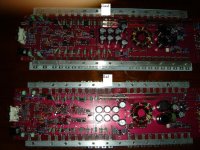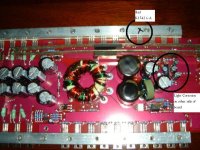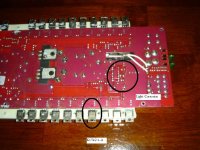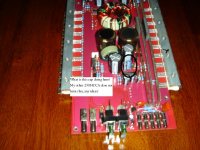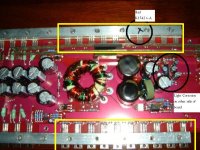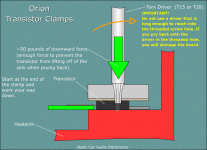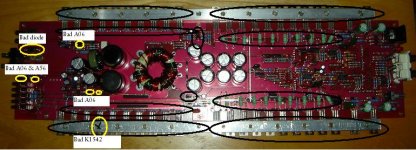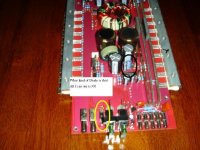Hi,
I’m a newbie and not an electrical engineer so please bear with me. Any help in this manner would be a huge help.
I have a few 250 hcca amps and have been running them for years(10+). I believe they are 2nd generations because they have the crossover modules under the removable top plate.
The other day all three hcca’s shut down and no power appeared without blowing any type of fuses. After checking everything, many hours later I found that one of my hcca is grounded out. When I say grounded out I mean that the positive power terminal is seeing a ground just like the negative power terminal.
This has caused a lot of system damage. It completely fried my mbr70 (Orion battery isolator) and an Optima deep cycle blue top. Since then, I have fixed my mbr70 and replaced my battery.
About my 250 hcca, the board looks pretty clean. There are a couple of very small spots of corrosion on the back side where the all the caps are on the power side. This would be the four small caps (two the same size and the other two differ sizes) by the two large ones. But, the caps look fine. I took one of my good 250 hcca’s apart so I could check out some of the values of the resistors, transistors, caps, and diodes. I’m just using a multi meter doing ohm and continuity checks.
My results…. It appears that one of the K1542 is out on the power supply side. That whole side is reading much lower than the other side across. So I plan on replacing that with a NTE2986 as soon as I can find one. Next some of the caps have a little different readings (ohms). Do I need to replace these? All the resistors seem to be fine. Also the large diode next to the input, I don’t know how to check.
What should I do next? Is this a common problem? What is the normal sequence for trouble shooting and replacement? Any help would be great! Thank you your time, Sean
I’m a newbie and not an electrical engineer so please bear with me. Any help in this manner would be a huge help.
I have a few 250 hcca amps and have been running them for years(10+). I believe they are 2nd generations because they have the crossover modules under the removable top plate.
The other day all three hcca’s shut down and no power appeared without blowing any type of fuses. After checking everything, many hours later I found that one of my hcca is grounded out. When I say grounded out I mean that the positive power terminal is seeing a ground just like the negative power terminal.
This has caused a lot of system damage. It completely fried my mbr70 (Orion battery isolator) and an Optima deep cycle blue top. Since then, I have fixed my mbr70 and replaced my battery.
About my 250 hcca, the board looks pretty clean. There are a couple of very small spots of corrosion on the back side where the all the caps are on the power side. This would be the four small caps (two the same size and the other two differ sizes) by the two large ones. But, the caps look fine. I took one of my good 250 hcca’s apart so I could check out some of the values of the resistors, transistors, caps, and diodes. I’m just using a multi meter doing ohm and continuity checks.
My results…. It appears that one of the K1542 is out on the power supply side. That whole side is reading much lower than the other side across. So I plan on replacing that with a NTE2986 as soon as I can find one. Next some of the caps have a little different readings (ohms). Do I need to replace these? All the resistors seem to be fine. Also the large diode next to the input, I don’t know how to check.
What should I do next? Is this a common problem? What is the normal sequence for trouble shooting and replacement? Any help would be great! Thank you your time, Sean
I beleive you have a 3rd. Generation orion. You should be able to check the diode in the circuit. Use your multi-meter on continuity and see if you have a short across the diode. If you haven't already, remove the bad from the heat sink and visiually check for any solder that may have heated up and flowed over and created a short. While your at it clean-up any built up flux (crusty brown and/or orange substance) underneath circuit board.
Getback@me
Getback@me
Hi,
So I plan on replacing that with a NTE2986 as soon as I can find one.
What is the normal sequence for trouble shooting and replacement?
I don't think you'll find anyone here to recommend NTE replacements. Best to use original parts if they are available. If not, ask here for successful substitutions. I wouldn't advise replacing a single transistor from a parallel group, it's likely you'll want to replace the whole side and possibly drivers, too. In other words, don't go ordering parts just yet.
Check Perry's wonderful site for tutorials and information on amp repair:
Basic Amplifier Repair
Also- look at the bottom of this page and you'll find links to other HCCA threads on this forum that may have relevant information for you.
Be patient, and you'll find enough help here to get you up and running again. The folks here make a great crowd.
It's surprising that a fuse didn't blow before the isolator toasted. Have you tried to power up the other two 250's since fixing it?
Last edited:
Can you post a photo of the inside of the amp?
I've never seen 2SK1542s used in Orion amps. Are there any other numbers on the face of the transistor?
Was the corrosion on the component side of the board or on the solder side of the board?
If you have one blown power supply FET, you must replace all of them if you want the amp to be as reliable as possible.
In most Orion amps, they drive the power supply transistors with an emitter follower pair (MPSA06/56) and leg 3 of the A56 is connected to ground by a 10 ohm resistor. Many times, the A56 and the 10 ohm resistor fail. Occasionally, the A06 fails. These need to be checked.
I agree, never use NTE parts in a car amplifier.
I've never seen 2SK1542s used in Orion amps. Are there any other numbers on the face of the transistor?
Was the corrosion on the component side of the board or on the solder side of the board?
If you have one blown power supply FET, you must replace all of them if you want the amp to be as reliable as possible.
In most Orion amps, they drive the power supply transistors with an emitter follower pair (MPSA06/56) and leg 3 of the A56 is connected to ground by a 10 ohm resistor. Many times, the A56 and the 10 ohm resistor fail. Occasionally, the A06 fails. These need to be checked.
I agree, never use NTE parts in a car amplifier.
More details
Thanks for everybody’s help!!!!! So I have posted some pictures for everybody to see.
Both amps are using the K1542 6-A. This is the only markings on them. I think one is bad because that whole side measures around 39 ohms; the opposite side is around 84 ohms. Plus that K1542 is much (1.3 ohms) lower that the rest (around 39 ohms) measuring the two outer post.
All the feed back is great. My terminology is not good at all and my skill level on electrical is poor at best. It would be great if when you suggest for me to check something if you could send a picture of what you would like me to check and tell me how to check it.
Thanks again for all the support; this is a top notch forum!!!!!!!!!!!!!!!!!!!!!!!
Thanks for everybody’s help!!!!! So I have posted some pictures for everybody to see.
Both amps are using the K1542 6-A. This is the only markings on them. I think one is bad because that whole side measures around 39 ohms; the opposite side is around 84 ohms. Plus that K1542 is much (1.3 ohms) lower that the rest (around 39 ohms) measuring the two outer post.
All the feed back is great. My terminology is not good at all and my skill level on electrical is poor at best. It would be great if when you suggest for me to check something if you could send a picture of what you would like me to check and tell me how to check it.
Thanks again for all the support; this is a top notch forum!!!!!!!!!!!!!!!!!!!!!!!
The 2sk1542 appears to be obsolete. I'd use either the IRF3205 or the NDP7060 (used in MANY Orion amps).
Digi-Key - IRF3205PBF-ND (Manufacturer - IRF3205PBF)
Digi-Key - NDP7060-ND (Manufacturer - NDP7060)
The extra cap may have been added to damp/slow the reaction to an input on pin 3 (can't tell if it's on pin 2 or 3).
Digi-Key - IRF3205PBF-ND (Manufacturer - IRF3205PBF)
Digi-Key - NDP7060-ND (Manufacturer - NDP7060)
The extra cap may have been added to damp/slow the reaction to an input on pin 3 (can't tell if it's on pin 2 or 3).
Perry,
Which one should I use? How many do I replace, some forums say to replace the whole side. Can I just buy them from ebay? Or get them from Didi-Key? It seems like they are a little different from what I have. Will this hurt anything? Any other ideas on what to test next?
Thanks,
Sean
Which one should I use? How many do I replace, some forums say to replace the whole side. Can I just buy them from ebay? Or get them from Didi-Key? It seems like they are a little different from what I have. Will this hurt anything? Any other ideas on what to test next?
Thanks,
Sean
I use the 3205s.
Replace the ones highlighted in the attached photo (assuming that all have the same part number).
Don't forget to order the driver components.
I'd order from digikey. The ones on eBay may be genuine but could be counterfeit. The ones from DK are going to be genuine. I'd order at least 25 from digikey. That will give you a better chance of getting all from the same batch (matching date codes).
Have you checked the output transistors to determine if any are shorted?
To break the transistors free from the clamps, use the method shown in the second image.
Replace the ones highlighted in the attached photo (assuming that all have the same part number).
Don't forget to order the driver components.
I'd order from digikey. The ones on eBay may be genuine but could be counterfeit. The ones from DK are going to be genuine. I'd order at least 25 from digikey. That will give you a better chance of getting all from the same batch (matching date codes).
Have you checked the output transistors to determine if any are shorted?
To break the transistors free from the clamps, use the method shown in the second image.
Attachments
Perry,
Ok, I will order atleast 25 of the 3205s from DigiKey and replace what you have highlighted as long they are all the same part number. I will follow your instructions to break away the clamps.
You asked me, "Don't forget to order the driver components".
What are the driver components?
Also, "Have you checked the output transistors to determine if any are shorted"?
Are you talking about all the transistors highlighted? If yes, I checked them with my meter by probing pin 1 and 2, 1 and 3 of each of them and all of them seem to have continuity together. Am I doing something wrong?
Thanks,
Sean
Ok, I will order atleast 25 of the 3205s from DigiKey and replace what you have highlighted as long they are all the same part number. I will follow your instructions to break away the clamps.
You asked me, "Don't forget to order the driver components".
What are the driver components?
Also, "Have you checked the output transistors to determine if any are shorted"?
Are you talking about all the transistors highlighted? If yes, I checked them with my meter by probing pin 1 and 2, 1 and 3 of each of them and all of them seem to have continuity together. Am I doing something wrong?
Thanks,
Sean
The driver components are the MPSA06, MPSA56 and 10 ohm resistors mentioned previously.
The highlighted transistors are the power supply transistors.
The output transistors have their 3rd leg connected to the large green resistors. Many times, the output transistors fail and cause the power supply transistors to fail.
To desolder the power supply or output transistors, apply enough new solder so that you can heat all 3 legs at once (laying your soldering iron tip across all of them) and wipe them off of the board. Desolder the pads with a desoldering pump and then desoldering braid (if needed).
http://www.bcae1.com/temp/removingpartsfromolderorionamplifiers01.avi
The highlighted transistors are the power supply transistors.
The output transistors have their 3rd leg connected to the large green resistors. Many times, the output transistors fail and cause the power supply transistors to fail.
To desolder the power supply or output transistors, apply enough new solder so that you can heat all 3 legs at once (laying your soldering iron tip across all of them) and wipe them off of the board. Desolder the pads with a desoldering pump and then desoldering braid (if needed).
http://www.bcae1.com/temp/removingpartsfromolderorionamplifiers01.avi
Last edited:
Tested Parts
So I tested most of the amps components. Please see the attached picture. Everything circled in the color black seems to uniform with each other and my working 250HCCA. Everything in yellow is NOT uniform and has different values. There seems to be a lot of bad components, am I testing these right? Is this common? Anything else I should test befoe I start ordering parts? Once again thanks for all your support.....Sean
So I tested most of the amps components. Please see the attached picture. Everything circled in the color black seems to uniform with each other and my working 250HCCA. Everything in yellow is NOT uniform and has different values. There seems to be a lot of bad components, am I testing these right? Is this common? Anything else I should test befoe I start ordering parts? Once again thanks for all your support.....Sean
Attachments
One final thing to check,off the topic! Since you have a 3rd. generation Orion 250 aka "Pop-Top" make sure to check metal fastners that attach to the metal cover.They do become lose and will destroy an amplifier.
As for replacment parts,I have bought some from ebay. The prices are cheaper but the are either counterfiet or genuine with ALL mismatch date codes. Since most techs perfer matching date codes in order for linear performance from devices.That leaves suppliers sometimes with misc genuine parts that they sell on ebay. Since this amp is your personal amp you can try ebay but be prepared for random devices not to be team players.
Use find.chips.com to compare prices they have trusted suppliers.
As for replacment parts,I have bought some from ebay. The prices are cheaper but the are either counterfiet or genuine with ALL mismatch date codes. Since most techs perfer matching date codes in order for linear performance from devices.That leaves suppliers sometimes with misc genuine parts that they sell on ebay. Since this amp is your personal amp you can try ebay but be prepared for random devices not to be team players.
Use find.chips.com to compare prices they have trusted suppliers.
Diode Question
Anybody know the make and model of this diode (circled in YELLOW)? I have not yet taken it off the board and would like to order one first. All I can see is ?00 on it. Please see the attached picture. Thanks for all the help...Sean
Anybody know the make and model of this diode (circled in YELLOW)? I have not yet taken it off the board and would like to order one first. All I can see is ?00 on it. Please see the attached picture. Thanks for all the help...Sean
Attachments
Last edited:
- Status
- This old topic is closed. If you want to reopen this topic, contact a moderator using the "Report Post" button.
- Home
- General Interest
- Car Audio
- 250 hcca grounded out problem
